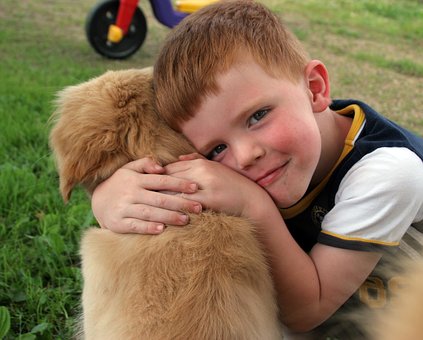Children are fascinated by animals. How often have you heard: “I want a puppy!” or “Oh, what a soft kitty, can we take it home?” While adorable, a pet comes with advantages and some disadvantages. Whether your family already has a pet (or pets) or you are considering the first pet for your family – here are things to consider before bringing a new animal home.
The bad:
- Some children may have allergies or other medical conditions that make having a family pet more challenging. A pet allergy results from over-sensitive immune systems that react to proteins in the urine, saliva, or dander of pets. An article on the Mayo Clinic website (mayoclinic.org) states that “Being exposed to pets at an early age may help you avoid pet allergies. Some studies have found that children who live with a dog in the first year of life may have better resistance to upper respiratory infections during childhood than kids who don’t have a dog at that age. However, someone with pet allergies may display reactions that range from mild to severe. If a family member has a known pet allergy, it may be best to forgo the family pet.
- Having a family pet is a huge commitment. Children pick up on family stress. If the family is so scheduled that the time and energy to care for a pet increases family stress, a pet may not be the best family addition at that time. Also, the family is responsible for keeping the pet safe. The children will need to understand what toys and other items could be hazardous to the pet and make sure they are kept out of reach. It can be traumatic for a child to realize that a pet was injured (or worse) because they left something in reach. Also, caring for a pet is a long-term commitment. Make sure the family can keep and provide for the pet through the duration of its lifespan.
- Interacting with animals always has a certain amount of risk. According to WebMD, “dogs bite about 4.7 million Americans every year, half of them children between ages 5 and 9.” The Center for Disease Control reports that one out of every five of those bites causes an injury that requires medical attention. Injuries can occur as the result of an accident, a poorly trained animal, a fearful animal, or a provoked animal. Parents and caregivers should recognize potential hazards, mitigate them whenever possible, and know the recommended first aid actions in case of injury.
The good:
- Having a pet in the family can positively impact a child’s physical development. An American Academy of Pediatrics study proved that young children with family pets (dogs and cats specifically) experienced fewer respiratory and ear infections than children who lived without pets. It is also believed that the immune system may be strengthened resulting in fewer sick days. Playing with pets – depending on the type of pet of course – promotes increased physical activity and exercise for children. Activities such as walking or playing ball with a dog are beneficial in helping children stay fit.
- Children are emotional and can quickly attach to a new pet. Children quickly build emotional relationships with their pet which offers the opportunity for children to receive unconditional love and support. Children also learn how to effectively communicate with their pet. They must demonstrate patience and problem-solving skills to encourage pets to cooperate as not all animals like to be put in doll clothes or pushed around the block in a stroller. Since pets are nonjudgmental, children feel free to confide their secrets and receive emotional support in the form of ‘kisses’ or other signs of affection. A family pet may become your child’s best friend.
- Family pets are a great way to teach children about responsibility. Age-appropriate duties can be assigned and expected to be done on a routine basis. First, children must learn that the pet depends on them. Making sure the pet has food and water develops children’s nurturing skills. Properly disposing of wastes reinforces the lesson that caregiving is not just nurturing. Children also learn that fitness is important. Walking the dog is not just playtime, but a vital part of keeping the dog healthy. Younger children may require adult supervision, but older children should be able to take on some of the pet ownership responsibilities.
- Having pets can reduce stress. “The act of petting your cat released oxytocin, the bonding hormone or ‘cuddle chemical’ which can make you feel less stressed,” says Melanie Greenberg, Ph.D., licensed clinical psychologies and author of The Stress Proof Brain. A child experiencing stress can use interactions with the family pet as a stress-coping mechanism.
Deciding whether to add a pet to the family is a major decision. The overall care and welfare of the child’s pet belong to the parents. It’s a life-long (for the pet) decision that shouldn’t be made without serious considerations of the advantages, disadvantages, and overall impact on the entire family.
Nannies seeking to learn more can enroll in the Specialist Nanny program at the the Nanny Institute which includes a course on Pet Care.


Recent Comments